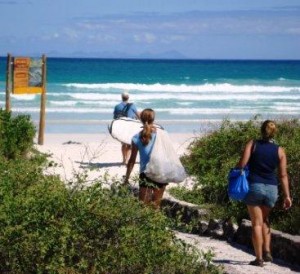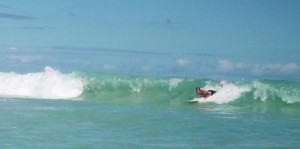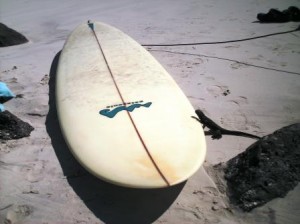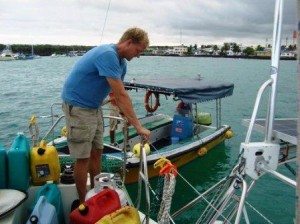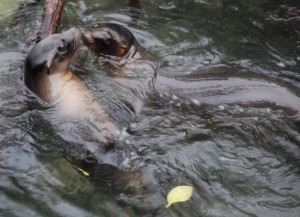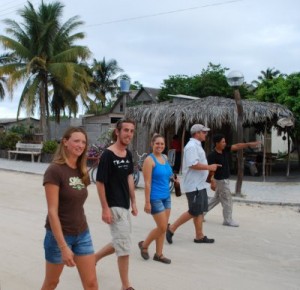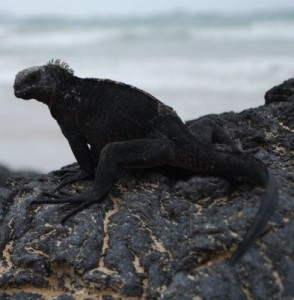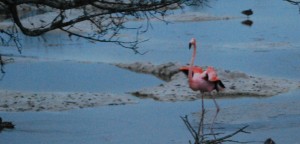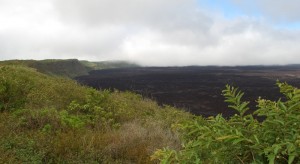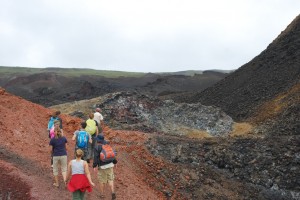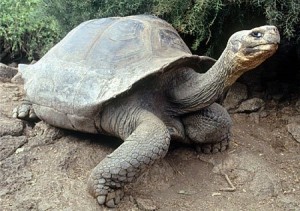Since returning from Isabela, we have struck a nice balance betweeen taking care of boat-related business and enjoying Puerto Ayora. I took Dallas up the mast on Sunday afternoon so he could assess the rigging, and he was pleased that everything was still in place and seemed to be secure. That night we found a restaurant that had the NBA finals on TV (with Spanish commentators). Dallas has been a Lakers fan for years (long before we moved to L.A.), so I was glad that he was able to see them clinch the championship. I was also glad to have the chance to skype with my parents that night. I am going to miss being able to see them as well as hear their voice when we are in the technologically primitive Marquesas Islands.
After a nice pancake breakfast that Tiff prepared on Monday morning, Dallas changed the oil on both engines. We then headed in for an afternoon at the beach. We thought we were taking a taxi to Tortuga Bay, but the taxi driver informed us that it was necessary to walk for 40 minutes. We unloaded our surfboard, snorkeling gear, backpacks, etc. and started walking. Despite the gear and the bright sun (it was the first clear day since we arrived here), it was a pleasant walk on a paved trail through the forest of cacti and deciduous trees. The beach was beautiful, and Dallas, Tiff, and I all took turns on the surfboard. The waves were great in terms of their height and frequency, but they closed out pretty quickly, so there wasn’t much time to try to stand up. I’m sure that experienced surfers could have handled it, but we are as novice as they come. Dallas seemed on the cusp of getting up, though, and I am determined to get there soon as well. After surfing we walked down to the bay, which was very peaceful but very murky, so we could have left the snorkeling gear on the boat. Some others that were just leaving told us that they had seen a big ray there, but I don’t think I would have seen anything in that green water until it brushed up against me.
Monday night was girls’ night out. Tiff had been craving sushi, which doesn’t appeal to the Clow brothers but definitely appeals to me. We went to a nice place overlooking Academy Bay where the boat is anchored. While the sushi was not the best we’d ever had, it served to satisfy the cravings. Afterward we stopped at a little place called Cafe Limon where we could get a cheap drink among both locals and tourists and take up space on the dance floor. They played a nice mix of salsa and American dance music. Naturally we had some unsolicited conversations with a few friendly Argentinian and Ecuadorian men. You might think that the fact that Tiff and I do not speak Spanish might have deterred them, but think again. They just kept talking, and eventually we’d understand a key word that would help them to communicate to us their occupation, for example. It was remniscent of the game show where you can say anything except the words you want to convey, and Tiff and I were pretty amused.
I did learn one word that I really like. It turns out that “Pachamama” is not just the name of a restaurant in Kansas where my best friend works but is a term used by the indigenous peoples of the Andes to mean Mother Earth. One of the guys who was born and raised in the Galapagos (he’s one of the endemic species, LOL) used this word several times, and Dallas and I saw it on a mural yesterday. Pachamama is revered on these islands.
Yesterday we went about the business of collecting water and diesel for the 3,000 mile journey to the Marquesas Islands. This going to be the longest passage of the whole circumnavigation, and thus it requires that we are all stocked up. Typically this is no big deal–we just pull up to a dock, plug in the fuel/water hoses, and go. However, this time we have had to supply using jerry jugs. For water, we took our jugs to and from shore using the water taxi, got them filled at the local desalinization plant, and carried them three blocks to the water taxi dock. We tried to do the same for fuel by taking our jugs in a taxi to the gas station but were told by the attendant that we would have to get a diesel permit from the port captain (i.e., pay more money since we are tourists). We had some forewarning that this would occur but were trying to get around it. Oh well.
Today we will take care of final provisioning and savor our last minutes of internet. I have been following the situation in Iran since their presidential election and will be interested to see how that plays out, although we probably will not read about it again until we get to the Marquesas in 3+ weeks! That also means that we may not get back to those of you who email us for a while, but keep those emails coming anyway! We love to hear from you!
We started by dropping our stuff off at the hotel, where we had a bit of a laugh. Lauren I left so soon after getting married, that we didn’t have a chance to have her name legally changed, passport re-issued, etc. When we arrived at the hotel, they had assigned Wes and I to share a room since we had the same last name. When I explained that we were brothers and we’d prefer to stay with the girls rather than each other, the proprietor had quite a laugh. The hotel was simple but cute, and we were looking forward to having internet, TV, air-conditioning, and hot water all together. It didn’t quite work out that way, but oh well. The TV was mostly in Spanish of course, but we did find a channel that had English with Spanish subtitles. We watched parts of a WWII sub movie that was a combination of German with Spanish subtitles and Spanish dubbing. We were able to follow a fair amount of it, but it was definitely easier to understand the German with Spanish subtitles than to try to understand the quickly spoken Spanish. I never did get any hot water, which makes my last hot shower on the other side of the Panama Canal with no hot shower in sight.
After dropping our stuff off at the hotel we met Julio, who was our guide while we were there, and took a walk around the town. Our tour that evening included a small mineral-laden lagoon with a couple of flamingos at the opposite edge (Lauren and I walked by later to get some pics of them much closer and got to see one fly) and a walk along the beach where we saw lots of marine iguanas and crabs as well as some local kids surfing. It is really amazing how well the marine iguanas blend into the black volcanic rocks. There have been several times when we were looking right at a couple of them and didn’t initially see them. Juliio left us for the evening and we did a little exploring and learned that there was an election in Ecuador on Sunday, so all the local beach-front bars were closed Friday, Saturday, and Sunday by law. That was a little disappointing because there were some really neat places with stools and hammocks right at the edge of the beach.
We had all of our meals included at the hotel, so we went back for a tasty dinner where we were warned by a fellow tourist that we would be in for a pretty rough day on Saturday (rain, mud, sunburn, weeds, brush, etc.). She seemed to complain about everything though so we pretty much ignored her. We also had a nice conversation with Zachi, an Isreali guy with our same itinerary in Isabela who is in the middle of an 8-month sightseeing trip that has included several parts of South America.
We were hoping for a good night’s sleep, but Lauren and I had left our windows open with no AC (we’re more than accustomed to it now, and the weather has been great) and about 4 in the morning, the neihborhood roosters started the morning crowing ritual. They seem to have a 6th sense with respect to how long they need to crow to wake up everybody in earshot, not stopping until breakfast is on the table. Oh well. We were excited to see a volcano and didn{t need a lot of sleep.
After breakfast we loaded up in what they termed a “bus”. It was a pick-up with a wooden structure on the back instead of a bed. It had three rows of seats, no seatbelts, and just an armrest to keep you from sliding out. Luckily, there’s not much in the way of traffic there, so no worries. We drove halfway up the mountain with steadily increasing mist until we got to a place where the horses were saddled and waiting for us. The local that worked with the horses picked one out for each of us and we saddled up. In general, the reins were just some roped tied to the halter & bit, the saddle blanket took a variety of forms (old rice bag, carpet, etc.), and some of the stirrups were tied to the saddles with ropes. We looked a little motley crew, with only one of us having any real amount of riding experience, but we set off into the fog. The guide had us continuously yelling at the horses to keep them moving faster, and we later found that the horse hand would ride in the back with a long rope and smack the hind end of the horses in the back. Needless to say, the horses didn’t like being the back and would ride up against each other trying to get closer to the front. There were lots of cries of “I’m sorry”, “Oooooo”, “Looks like I’m passing you…”, etc. My horse seemed to be a little too weak to make the trip, and in the very muddy conditions kept slipping, falling down almost to it’s knees once on the way there and again on the way back in some very muddy sections. I was able to keep my balance and stay on, but I was definitely thinking about how to get out of the way of the other spooked horses if I fell off.
We climbed to the top of the mountain, and then got to ride for a mile or two along the edge of the cauldron of Volcano Sierra Negra. The clouds were only covering about half of the cauldron at the time, which made it quite a spectacular sight. The volcano last erupted in 2004 or 2005, and the eruption was farily weak. All of the lava stayed in the cauldron and only covered about 60% of the surface area there. All of the people in the town actually came up and stood at the edge of the cauldron to watch. After viewing the cauldron, Julio led us on a walking tour along the other side of the volcano (Volcan Chico). Here there were several small craters off of the same magma chamber, with the last eruption 30 years ago. Parts of it were like walking on the surface of another planet. Seeing the different kinds of rocks with a variety colors dependent on their mineral makeup was amazing. There were lava tunnels, a lava river, folds of lava, a lava waterfall, and several small craters. We had lunch at and altitude of about 850 meters overlooking the dry side of mountain. From where we sat we could see the area where the lava from the next large volcano farther north had flowed toward the lava from this volcano and formed a connected island with a bay on each side, sort of like an hourglass shape.
We reversed the horse and bus conveyance back to the hotel. The horse ride was a little hair-raising with all of the mist/rain that had fallen. Tiffany was yelling/screaming almost the whole way back as her horse would ride along the edge of the brush, trot by brushing against other horses to avoid the horse hand, and then go sliding/trotting quickly down slippery downhill secions. The bus ride was pretty uneventful except for the milk cow that had wondered into the road and was chased by the bus for half a mile or so. We got 10 minute at the hotel to change clothes, pick up snorkeling gear, and load up for Tintoreras. Tintoreras is the Spanish word the the white-tipped shark and is the name they’ve given to a small island area by the entrance channel to the harbor. This turned out to be a pretty amazing place. within a distance of only half a mile or so we saw numerous white-tipped sharks swimming in a small channel off of the little lagoon, lots and lots of marine iguanas, sea turtles, sea lions, blue-footed boobies, and Galapagos penguins. Pretty amazing stuff. The snorkeling was only so-so. The visibility wasn’t very good so we only stayed in half an hour or so. We did see angelfish, several other colorful fish, and a couple of 3-4 foot rays.
We were pretty tired after a long day, so after dinner we relaxed in our rooms and went to bed early. The bus left for the dock at 5:30am and we were back in Puerto Ayora by 8:30am. We asked around and the locals pointed us to a local restaurant facing the harbor for breakfast. It was great food again. Wes was adventerous and tried the Bolon con Queso — banana dumpling with cheese, which seemed to be one of the more common selections among the other people at the small restaurant. Then it was back to the boat for a nap and a closer look at the rigging. The mast has moved in the mast base and seems to be moving more than it seems like it should, so I’m looking things over, taking some pics, and talking to Colin at Mack Sails to try to make sure everything is OK before we take off for the Marquesas.
We pared the pictures we took down to 600 or so, but it is still going to take a few days to get them all uploaded, so be sure to check back.
Yesterday we visited the Charles Darwin Research Center here on Santa Cruz Island, just a short walk from the town of Puerto Ayora. It was truly awesome. Regardless of one’s views regarding his theory of evolution, Darwin deserves tremendous credit for putting the Galapagos on the map. These islands are just teeming with wildlife of both the marine- and land-dwelling varieties. Many of the species of birds, iguanas, tortoises, etc. are not seen anywhere else in the world. I also think the country of Ecuador gets credit for balancing the desire to generate revenue with the need to preserve the natural habitats of these creatures. (Of course the latter contributes to the former.)
Prior to these recent conservation efforts, foreign animals such as goats, rats, and feral cats that had been brought to the islands competed for resources, altered the habitats, and left some of the endemic species vulnerable, endangered, or critically endangered. One such species is the Española tortoise, which had dropped down to 15 in number. The conservationists intervened by keeping the remaining tortoises in captivity and transferring their eggs into artificial incubators powered by hair dryers! Following the hatching of the eggs, the young tortoises are kept in captivity there at the Center until they are 3-5 years old, at which time they transfer them to the island of Española. Thanks to the efforts of the Darwin Center, there are now over 1,000 of these tortoises, and they are really cool to watch as they saunter around, seemingly in slow motion.
In addition to the Española tortoises, the Center houses Giant Galapagos tortoises, the one and only Pinta Tortoise in existence called Lonesome George (see Wes’ blog for more info), and a couple of land iguanas. There is also an abundance of finches of many varieties with their distinctly different beaks (it is easy to see how these piqued Darwin’s curiosity), lizards. On the beach nearby, Dallas and I saw some marine iguanas that blended perfectly with the volcanic rock as well as a couple of varieties of crabs.
Wes and Tiffany visited the Center yesterday morning, and Dallas and I checked it out later in the afternoon. Between the two trips, many photos were taken (use the link above to check them out), some of which seem to almost capture the experience of seeing these creatures in person. They are all accustomed to people, so it is possible to get really close to them. Thanks to Wes for taking the time to organize, crop, and label all the photos.
The four of us are now packed and ready for a 2-day excursion to the neighboring Isabela island. We are taking a little speedboat over this afternoon and will stay in a hotel for the next 2 nights (you know what that means–hot showers!!). Tomorrow we are told that we will snorkel in crystalline water among diverse fish, dolphins, and flamingoes, go horseback riding along the volcanic landscape, and observe the sea lions, gulls, and boobies (birds, mind you). It should be great fun! We have the camera with us, and as our photojournalist friend Colin has reminded us, we can’t take too many pictures!
{Thursday}
We just got back from our first encounter with Lonesome George. There were originally 14 species of Giant Tortoise in the Galapagos. The pirates, whalers, and settlers who firstcame to the Islands eradicated 3 species and decimated the other populations by 90%. It is easy to see why. The Giant Tortoise live a year without food or water so they made the perfect meat stock on old sailing ships.
In 1972 scientists found Lonesome George. He is a Pinta species. There have been no other discoveries of any other of his species since then. George is alone, the last of his kind. He is estimated to be 60-90 years old. Most of these Giant Tortoise live to be about 100 years old. When George dies, the species dies with him.
With these facts in mind it was a special experience to not only see the famous Tortoises, but also Lonesome George himself.
He is penned with two females of a different species, but growing up alone he did not learn social or mating behavior so attempts at mating have been unsuccessful. Cloning is an outside possibility, but has not been tried yet.
We also saw land iguanas that were very brightly colored and quite beautiful, but there are actually places where you can walk among and touch the Giant Tortoises, which was very cool to say the least.
Lauren and I did some more boat work this morning before heading in for sight-seeing. We worked on re-marking the anchor chain every 25´ (all but the last part that´s in the water now), repairing our main cabin door latch/lock, and checking out the bottom. The visibility isn´t too great here in Academy Bay, but we were able to clean off some nasty brown algae that has grown above the waterline in the areas that are temprorarily submerged when we´re sailing. It grew on the way from Panama and we´d never seen it before. We also cleared the last of the fishing line off of the port prop, where we noticed that the line spinning on the prop abraded a couple spots down to the glass on the rudder — that will be a project for another day. We checked the zincs on the shafts and they look fine, so we´re good to go in terms of bottom work until the next anchorage.
The internet is really, really slow all over town today, so we´ll catch you up on today´s exciting adventures tomorrow. In the meantime, here are some answers to questions from the mailbag. We got a cool e-mail from Dave in Chicago and here are answers to his questions. Feel free to send us some questions if you have them and we´ll get to them when we get a chance. If you want to comment on a blog, you can click on the conversation bubble that´s to the left of the blog title.
Q: Have you been able to do any scuba diving? Also, what certifications (if any) do you have? How do you refill your tanks?
A: Not yet. That´s been disappointing, but hopefully that will change soon. We all have PADI Open Water certifications, which is the basic SCUBA cert, as well as our own gear. We have a compressor on-board (Max Air 3500) that Lauren bought because she expecially loves to dive and want to be able to do it when we want to. Unfortunately, we´ve either been trying to make up time or in places where the diving wasn´t very good. We´ll definitely post about our first dive.
Q: Do you ever catch your dinner fishing?
A: Lots of cruisers do this, and we´ve heard about a really great book on fishing that was written for cruisers by a marine biologist, but we don´t have a copy. We´ve picked up tips here and there and have tried a line behind the boat, but haven´t had any luck yet. Lots of people catch Mahi Mahi, Tuna, Dorado, etc. so we´re looking forward to our first fishing success.
Q: Have you gotten any better at wind-surfing?
A: Another disappointing no here. We need to stop being so lazy and drag the board to a place where the seas are reasonable and there´s some wind. The water was a little nasty in Panama.
Q: And, most of all, how in the hell did you convince the girls to do this???
A: Books have been written on how to pull this off successfully. Lauren read one called “The Sailing Promise” that was written by a woman who was blackmailed/cajoled/bargained/… into going with promises of marriage before and children after. First I found a girlfriend then wife that I thought would give me pretty good odds at pulling this off. It was just hard to imagine myself with someone that wouldn´t be into this sort of thing and I ended up being lucky. In terms of the specifics, I´d always talked about something like this and we read some sailing books togehter that gave both of us a better idea of what it would be like. We´d also travelled a fair amount together beforehand and knew that we both enjoyed travel and a basic lifestyle. BUT, this is really a question that takes two to answer, so here´s Lauren´s take on it…..
Lauren here. I have always loved traveling, and I thought that this trìp sounded like an amazing opportunity. Actually, I know plenty of women who are just as adventurous as men, but like me, they probably have competing priorities such as the desire to have a family. As for me, I feel very fortunate to have the chance to have both experiences, since we are doing this early enough (just barely!) that we can have children when we return.



